Quality in Healthcare: Management Systems and Clinical Settings
VerifiedAdded on 2020/03/04
|10
|2135
|342
Report
AI Summary
This report delves into the multifaceted concept of quality in healthcare, defining its significance and exploring key elements of total quality management (TQM) and continuous quality improvement (CQI) within the healthcare context. It emphasizes patient safety as the cornerstone of high-quality care, differentiating between safety in healthcare and patient safety, and highlighting essential patient safety practices. The report further identifies and explains key organizational factors that either support or inhibit the implementation of effective quality management systems in hospital facilities, such as management commitment, customer satisfaction, and quality measurement systems. It explores the concept of 'safety culture' in healthcare, its measurement, and its impact on healthcare professionals and patients. Finally, it addresses the crucial role of clinical leaders in ensuring quality improvement within clinical settings, emphasizing their strategies and leadership in achieving safe and efficient patient care. The report draws upon various research papers and studies to support its analysis and provide a comprehensive understanding of the subject.
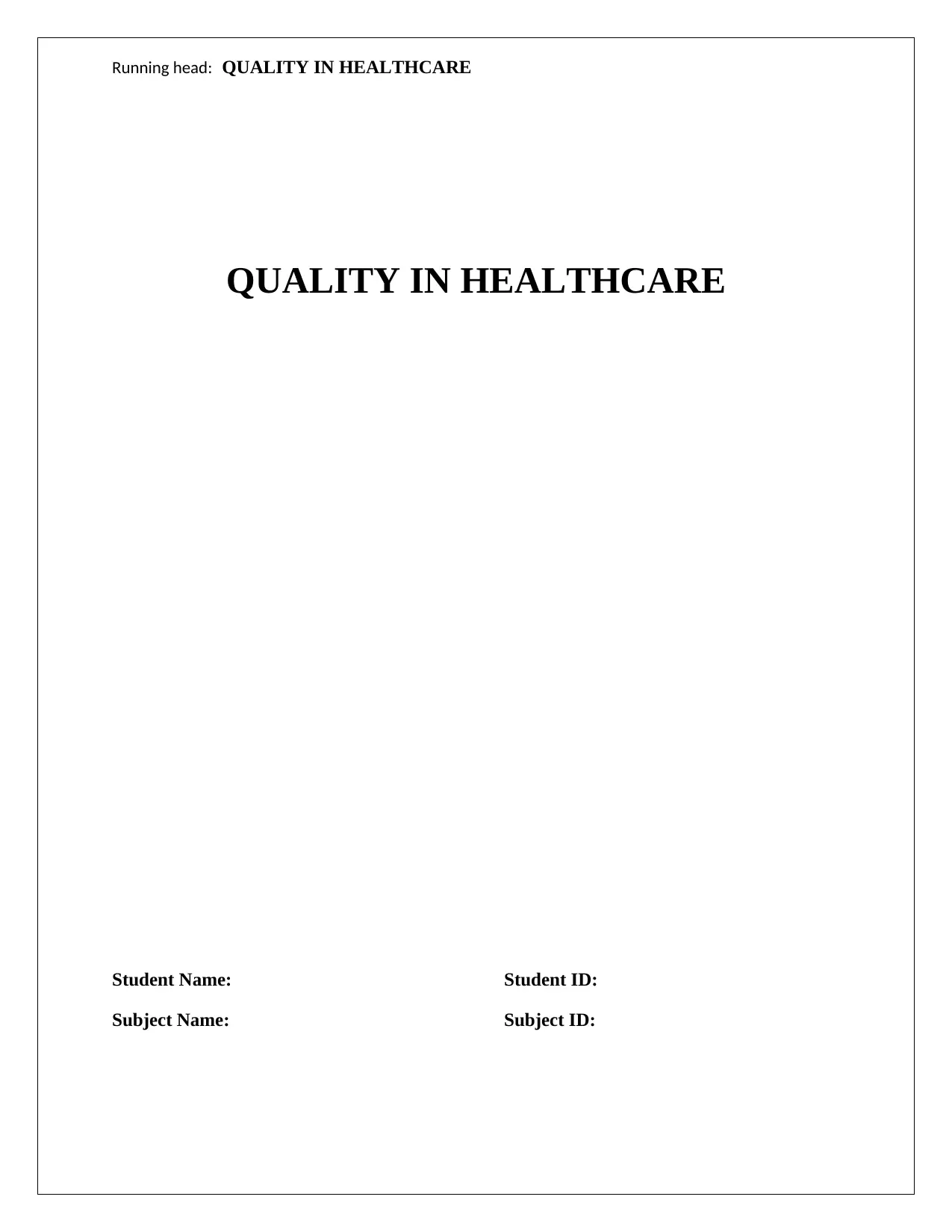
Running head: QUALITY IN HEALTHCARE
QUALITY IN HEALTHCARE
Student Name: Student ID:
Subject Name: Subject ID:
QUALITY IN HEALTHCARE
Student Name: Student ID:
Subject Name: Subject ID:
Paraphrase This Document
Need a fresh take? Get an instant paraphrase of this document with our AI Paraphraser
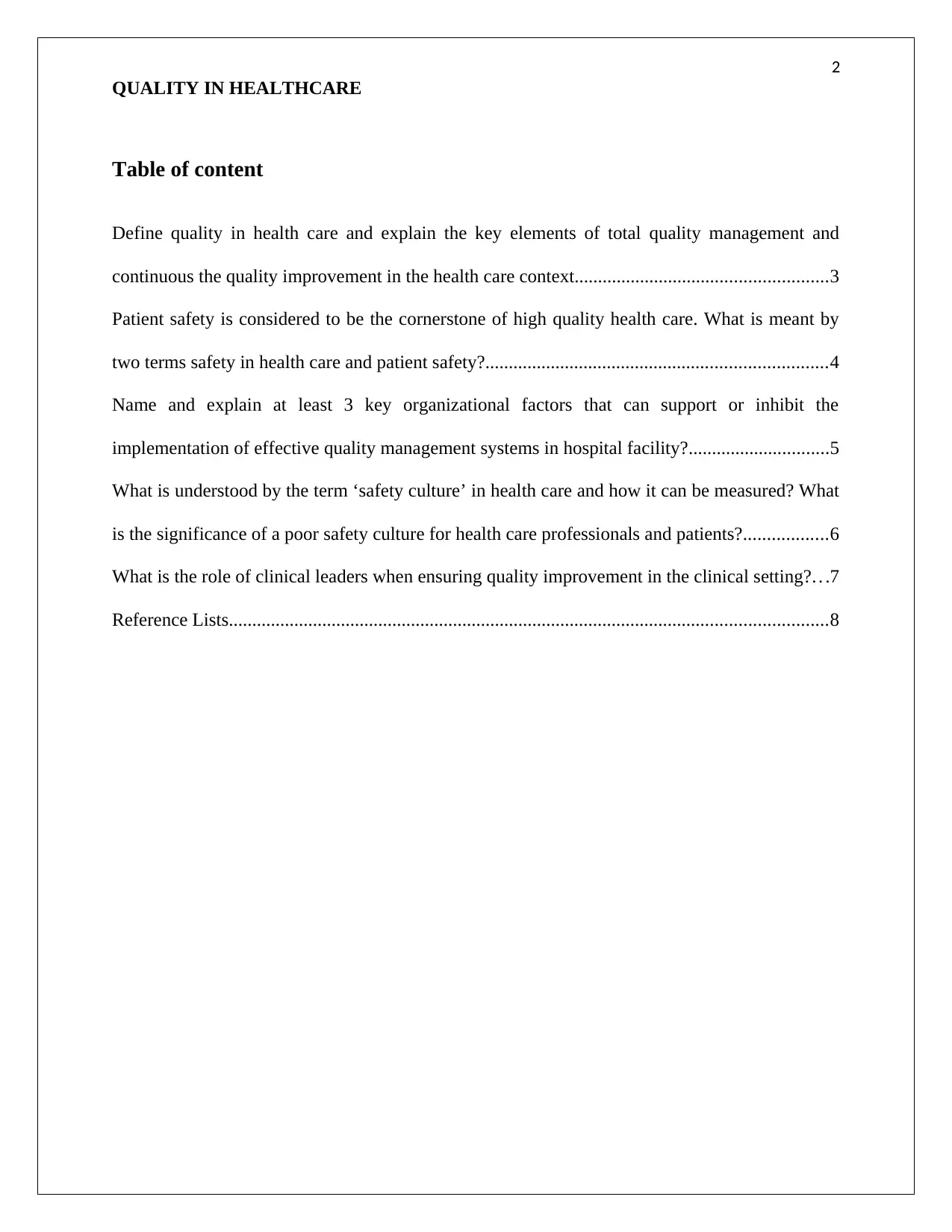
2
QUALITY IN HEALTHCARE
Table of content
Define quality in health care and explain the key elements of total quality management and
continuous the quality improvement in the health care context......................................................3
Patient safety is considered to be the cornerstone of high quality health care. What is meant by
two terms safety in health care and patient safety?.........................................................................4
Name and explain at least 3 key organizational factors that can support or inhibit the
implementation of effective quality management systems in hospital facility?..............................5
What is understood by the term ‘safety culture’ in health care and how it can be measured? What
is the significance of a poor safety culture for health care professionals and patients?..................6
What is the role of clinical leaders when ensuring quality improvement in the clinical setting?. . .7
Reference Lists................................................................................................................................8
QUALITY IN HEALTHCARE
Table of content
Define quality in health care and explain the key elements of total quality management and
continuous the quality improvement in the health care context......................................................3
Patient safety is considered to be the cornerstone of high quality health care. What is meant by
two terms safety in health care and patient safety?.........................................................................4
Name and explain at least 3 key organizational factors that can support or inhibit the
implementation of effective quality management systems in hospital facility?..............................5
What is understood by the term ‘safety culture’ in health care and how it can be measured? What
is the significance of a poor safety culture for health care professionals and patients?..................6
What is the role of clinical leaders when ensuring quality improvement in the clinical setting?. . .7
Reference Lists................................................................................................................................8
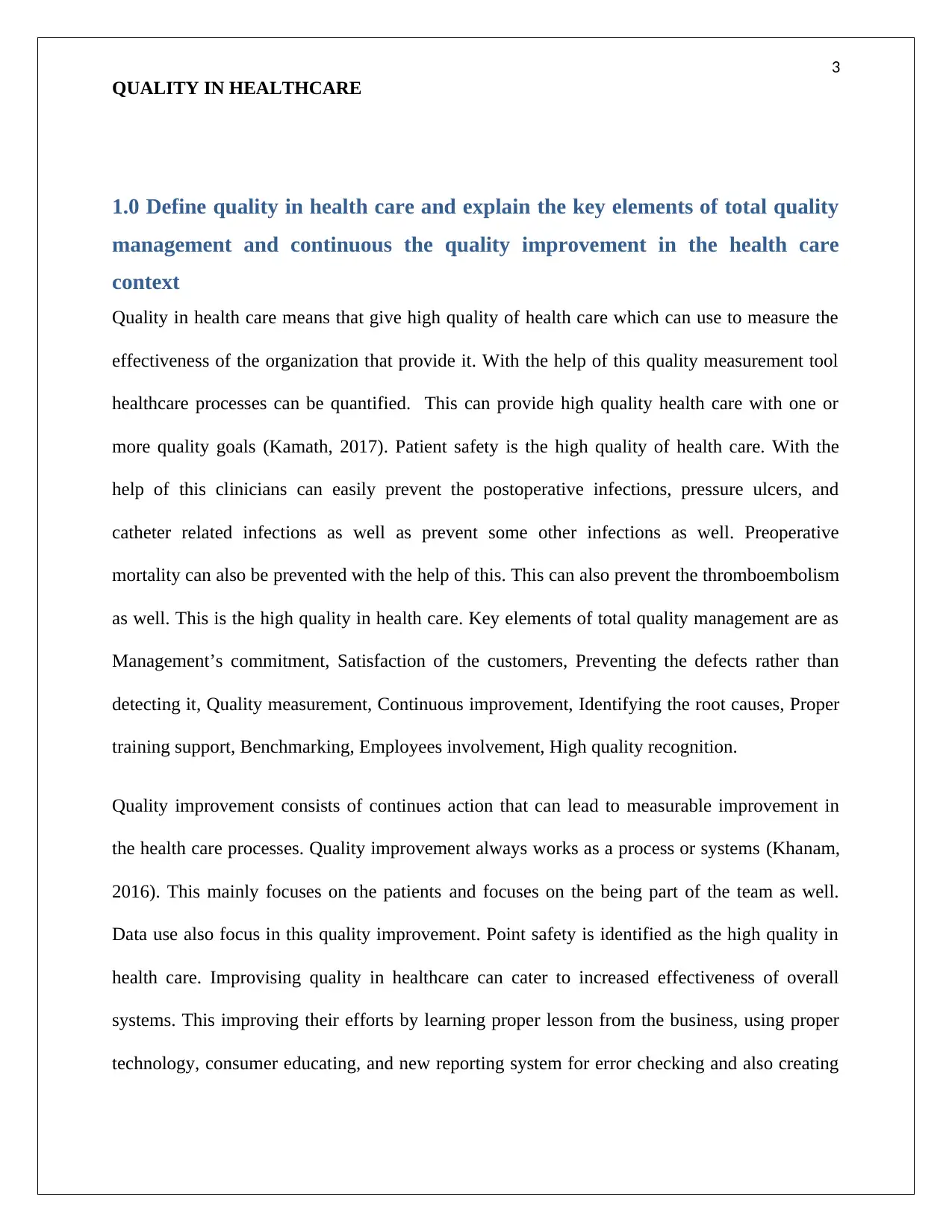
3
QUALITY IN HEALTHCARE
1.0 Define quality in health care and explain the key elements of total quality
management and continuous the quality improvement in the health care
context
Quality in health care means that give high quality of health care which can use to measure the
effectiveness of the organization that provide it. With the help of this quality measurement tool
healthcare processes can be quantified. This can provide high quality health care with one or
more quality goals (Kamath, 2017). Patient safety is the high quality of health care. With the
help of this clinicians can easily prevent the postoperative infections, pressure ulcers, and
catheter related infections as well as prevent some other infections as well. Preoperative
mortality can also be prevented with the help of this. This can also prevent the thromboembolism
as well. This is the high quality in health care. Key elements of total quality management are as
Management’s commitment, Satisfaction of the customers, Preventing the defects rather than
detecting it, Quality measurement, Continuous improvement, Identifying the root causes, Proper
training support, Benchmarking, Employees involvement, High quality recognition.
Quality improvement consists of continues action that can lead to measurable improvement in
the health care processes. Quality improvement always works as a process or systems (Khanam,
2016). This mainly focuses on the patients and focuses on the being part of the team as well.
Data use also focus in this quality improvement. Point safety is identified as the high quality in
health care. Improvising quality in healthcare can cater to increased effectiveness of overall
systems. This improving their efforts by learning proper lesson from the business, using proper
technology, consumer educating, and new reporting system for error checking and also creating
QUALITY IN HEALTHCARE
1.0 Define quality in health care and explain the key elements of total quality
management and continuous the quality improvement in the health care
context
Quality in health care means that give high quality of health care which can use to measure the
effectiveness of the organization that provide it. With the help of this quality measurement tool
healthcare processes can be quantified. This can provide high quality health care with one or
more quality goals (Kamath, 2017). Patient safety is the high quality of health care. With the
help of this clinicians can easily prevent the postoperative infections, pressure ulcers, and
catheter related infections as well as prevent some other infections as well. Preoperative
mortality can also be prevented with the help of this. This can also prevent the thromboembolism
as well. This is the high quality in health care. Key elements of total quality management are as
Management’s commitment, Satisfaction of the customers, Preventing the defects rather than
detecting it, Quality measurement, Continuous improvement, Identifying the root causes, Proper
training support, Benchmarking, Employees involvement, High quality recognition.
Quality improvement consists of continues action that can lead to measurable improvement in
the health care processes. Quality improvement always works as a process or systems (Khanam,
2016). This mainly focuses on the patients and focuses on the being part of the team as well.
Data use also focus in this quality improvement. Point safety is identified as the high quality in
health care. Improvising quality in healthcare can cater to increased effectiveness of overall
systems. This improving their efforts by learning proper lesson from the business, using proper
technology, consumer educating, and new reporting system for error checking and also creating
⊘ This is a preview!⊘
Do you want full access?
Subscribe today to unlock all pages.

Trusted by 1+ million students worldwide
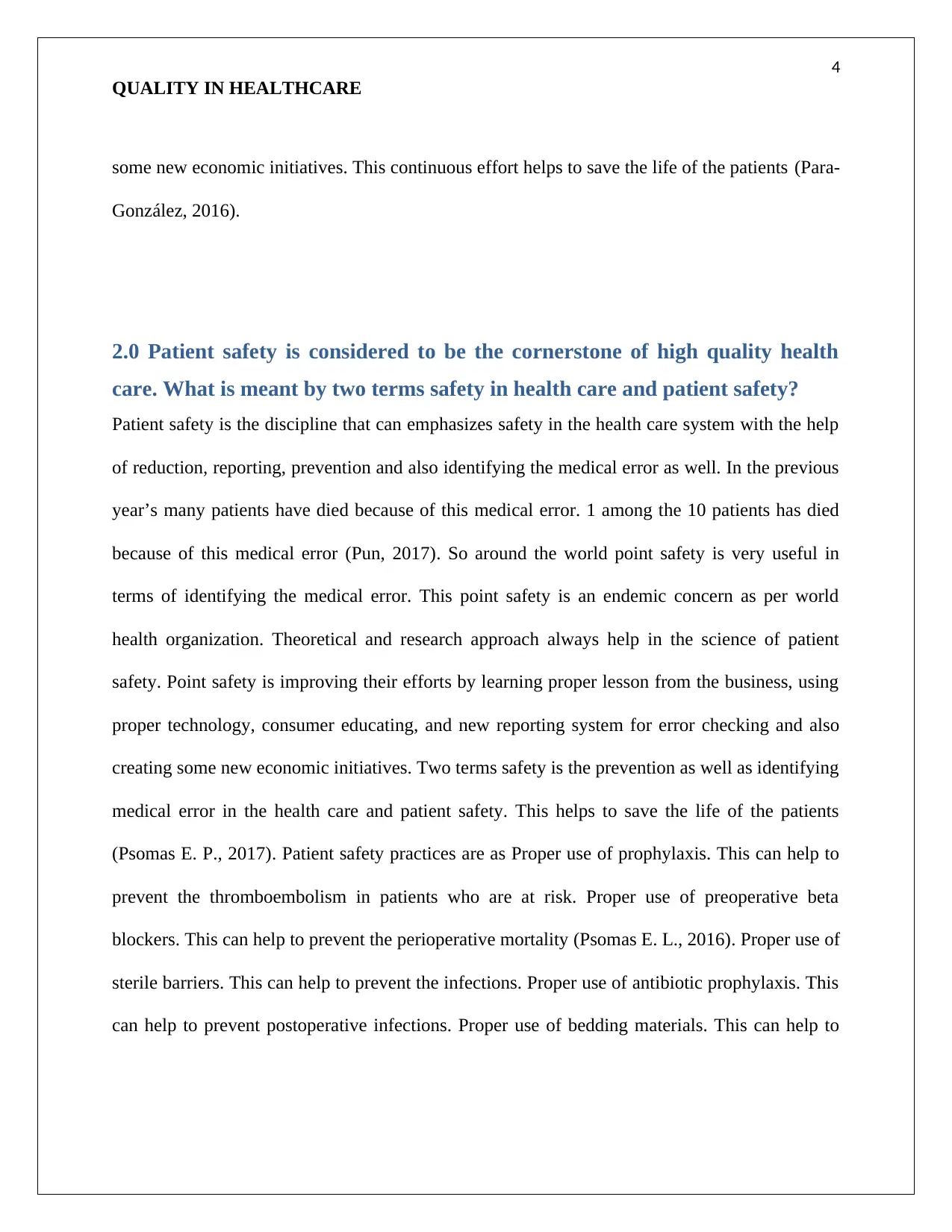
4
QUALITY IN HEALTHCARE
some new economic initiatives. This continuous effort helps to save the life of the patients (Para-
González, 2016).
2.0 Patient safety is considered to be the cornerstone of high quality health
care. What is meant by two terms safety in health care and patient safety?
Patient safety is the discipline that can emphasizes safety in the health care system with the help
of reduction, reporting, prevention and also identifying the medical error as well. In the previous
year’s many patients have died because of this medical error. 1 among the 10 patients has died
because of this medical error (Pun, 2017). So around the world point safety is very useful in
terms of identifying the medical error. This point safety is an endemic concern as per world
health organization. Theoretical and research approach always help in the science of patient
safety. Point safety is improving their efforts by learning proper lesson from the business, using
proper technology, consumer educating, and new reporting system for error checking and also
creating some new economic initiatives. Two terms safety is the prevention as well as identifying
medical error in the health care and patient safety. This helps to save the life of the patients
(Psomas E. P., 2017). Patient safety practices are as Proper use of prophylaxis. This can help to
prevent the thromboembolism in patients who are at risk. Proper use of preoperative beta
blockers. This can help to prevent the perioperative mortality (Psomas E. L., 2016). Proper use of
sterile barriers. This can help to prevent the infections. Proper use of antibiotic prophylaxis. This
can help to prevent postoperative infections. Proper use of bedding materials. This can help to
QUALITY IN HEALTHCARE
some new economic initiatives. This continuous effort helps to save the life of the patients (Para-
González, 2016).
2.0 Patient safety is considered to be the cornerstone of high quality health
care. What is meant by two terms safety in health care and patient safety?
Patient safety is the discipline that can emphasizes safety in the health care system with the help
of reduction, reporting, prevention and also identifying the medical error as well. In the previous
year’s many patients have died because of this medical error. 1 among the 10 patients has died
because of this medical error (Pun, 2017). So around the world point safety is very useful in
terms of identifying the medical error. This point safety is an endemic concern as per world
health organization. Theoretical and research approach always help in the science of patient
safety. Point safety is improving their efforts by learning proper lesson from the business, using
proper technology, consumer educating, and new reporting system for error checking and also
creating some new economic initiatives. Two terms safety is the prevention as well as identifying
medical error in the health care and patient safety. This helps to save the life of the patients
(Psomas E. P., 2017). Patient safety practices are as Proper use of prophylaxis. This can help to
prevent the thromboembolism in patients who are at risk. Proper use of preoperative beta
blockers. This can help to prevent the perioperative mortality (Psomas E. L., 2016). Proper use of
sterile barriers. This can help to prevent the infections. Proper use of antibiotic prophylaxis. This
can help to prevent postoperative infections. Proper use of bedding materials. This can help to
Paraphrase This Document
Need a fresh take? Get an instant paraphrase of this document with our AI Paraphraser
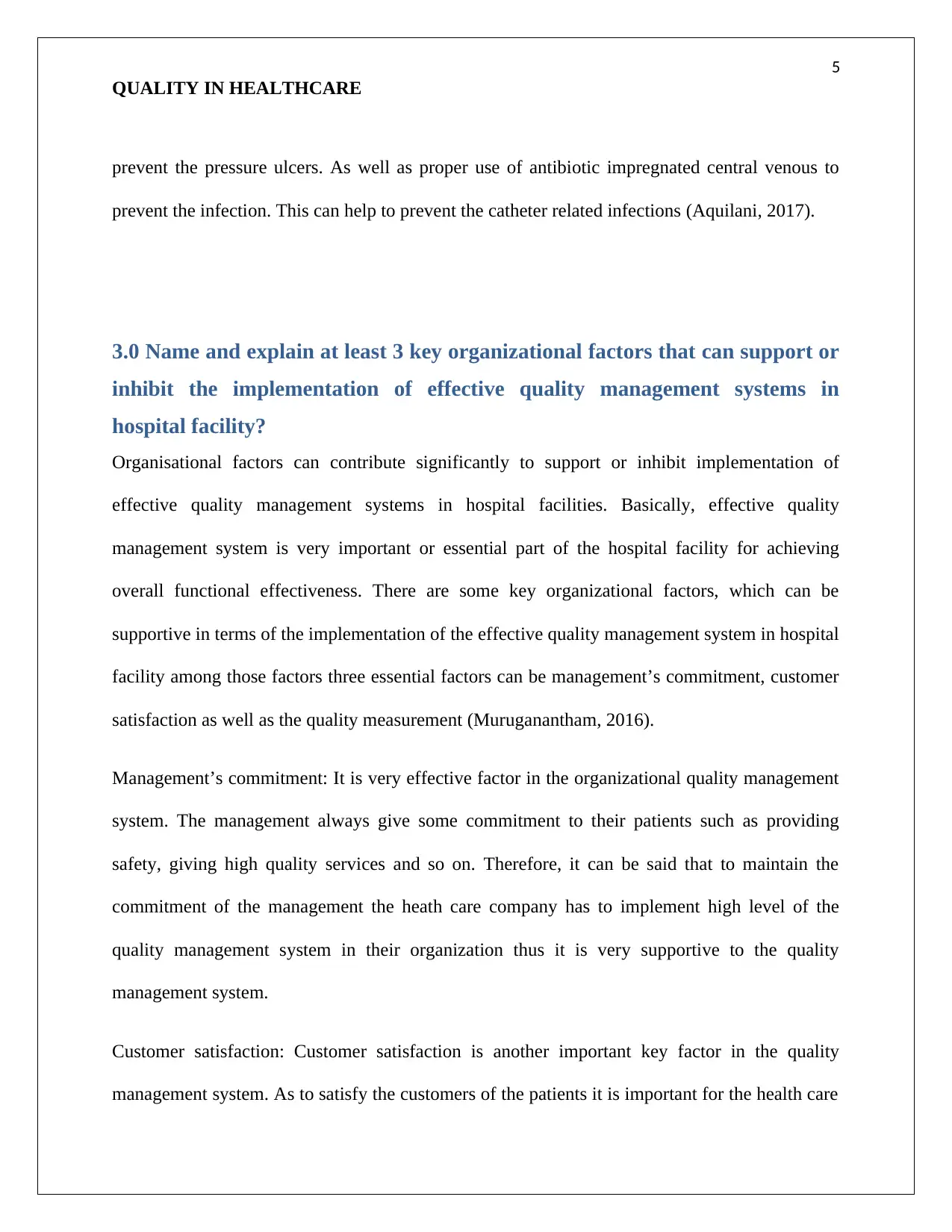
5
QUALITY IN HEALTHCARE
prevent the pressure ulcers. As well as proper use of antibiotic impregnated central venous to
prevent the infection. This can help to prevent the catheter related infections (Aquilani, 2017).
3.0 Name and explain at least 3 key organizational factors that can support or
inhibit the implementation of effective quality management systems in
hospital facility?
Organisational factors can contribute significantly to support or inhibit implementation of
effective quality management systems in hospital facilities. Basically, effective quality
management system is very important or essential part of the hospital facility for achieving
overall functional effectiveness. There are some key organizational factors, which can be
supportive in terms of the implementation of the effective quality management system in hospital
facility among those factors three essential factors can be management’s commitment, customer
satisfaction as well as the quality measurement (Muruganantham, 2016).
Management’s commitment: It is very effective factor in the organizational quality management
system. The management always give some commitment to their patients such as providing
safety, giving high quality services and so on. Therefore, it can be said that to maintain the
commitment of the management the heath care company has to implement high level of the
quality management system in their organization thus it is very supportive to the quality
management system.
Customer satisfaction: Customer satisfaction is another important key factor in the quality
management system. As to satisfy the customers of the patients it is important for the health care
QUALITY IN HEALTHCARE
prevent the pressure ulcers. As well as proper use of antibiotic impregnated central venous to
prevent the infection. This can help to prevent the catheter related infections (Aquilani, 2017).
3.0 Name and explain at least 3 key organizational factors that can support or
inhibit the implementation of effective quality management systems in
hospital facility?
Organisational factors can contribute significantly to support or inhibit implementation of
effective quality management systems in hospital facilities. Basically, effective quality
management system is very important or essential part of the hospital facility for achieving
overall functional effectiveness. There are some key organizational factors, which can be
supportive in terms of the implementation of the effective quality management system in hospital
facility among those factors three essential factors can be management’s commitment, customer
satisfaction as well as the quality measurement (Muruganantham, 2016).
Management’s commitment: It is very effective factor in the organizational quality management
system. The management always give some commitment to their patients such as providing
safety, giving high quality services and so on. Therefore, it can be said that to maintain the
commitment of the management the heath care company has to implement high level of the
quality management system in their organization thus it is very supportive to the quality
management system.
Customer satisfaction: Customer satisfaction is another important key factor in the quality
management system. As to satisfy the customers of the patients it is important for the health care
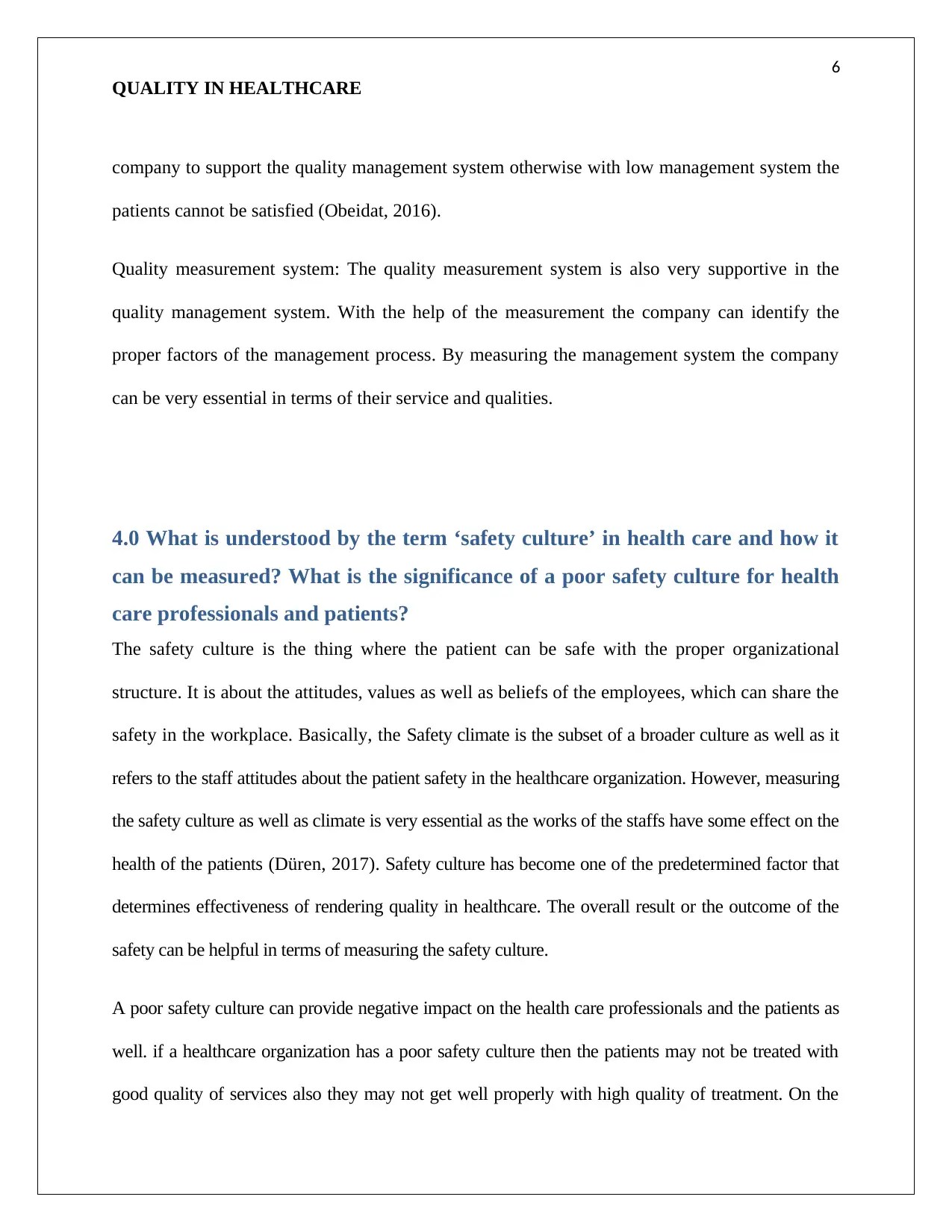
6
QUALITY IN HEALTHCARE
company to support the quality management system otherwise with low management system the
patients cannot be satisfied (Obeidat, 2016).
Quality measurement system: The quality measurement system is also very supportive in the
quality management system. With the help of the measurement the company can identify the
proper factors of the management process. By measuring the management system the company
can be very essential in terms of their service and qualities.
4.0 What is understood by the term ‘safety culture’ in health care and how it
can be measured? What is the significance of a poor safety culture for health
care professionals and patients?
The safety culture is the thing where the patient can be safe with the proper organizational
structure. It is about the attitudes, values as well as beliefs of the employees, which can share the
safety in the workplace. Basically, the Safety climate is the subset of a broader culture as well as it
refers to the staff attitudes about the patient safety in the healthcare organization. However, measuring
the safety culture as well as climate is very essential as the works of the staffs have some effect on the
health of the patients (Düren, 2017). Safety culture has become one of the predetermined factor that
determines effectiveness of rendering quality in healthcare. The overall result or the outcome of the
safety can be helpful in terms of measuring the safety culture.
A poor safety culture can provide negative impact on the health care professionals and the patients as
well. if a healthcare organization has a poor safety culture then the patients may not be treated with
good quality of services also they may not get well properly with high quality of treatment. On the
QUALITY IN HEALTHCARE
company to support the quality management system otherwise with low management system the
patients cannot be satisfied (Obeidat, 2016).
Quality measurement system: The quality measurement system is also very supportive in the
quality management system. With the help of the measurement the company can identify the
proper factors of the management process. By measuring the management system the company
can be very essential in terms of their service and qualities.
4.0 What is understood by the term ‘safety culture’ in health care and how it
can be measured? What is the significance of a poor safety culture for health
care professionals and patients?
The safety culture is the thing where the patient can be safe with the proper organizational
structure. It is about the attitudes, values as well as beliefs of the employees, which can share the
safety in the workplace. Basically, the Safety climate is the subset of a broader culture as well as it
refers to the staff attitudes about the patient safety in the healthcare organization. However, measuring
the safety culture as well as climate is very essential as the works of the staffs have some effect on the
health of the patients (Düren, 2017). Safety culture has become one of the predetermined factor that
determines effectiveness of rendering quality in healthcare. The overall result or the outcome of the
safety can be helpful in terms of measuring the safety culture.
A poor safety culture can provide negative impact on the health care professionals and the patients as
well. if a healthcare organization has a poor safety culture then the patients may not be treated with
good quality of services also they may not get well properly with high quality of treatment. On the
⊘ This is a preview!⊘
Do you want full access?
Subscribe today to unlock all pages.

Trusted by 1+ million students worldwide
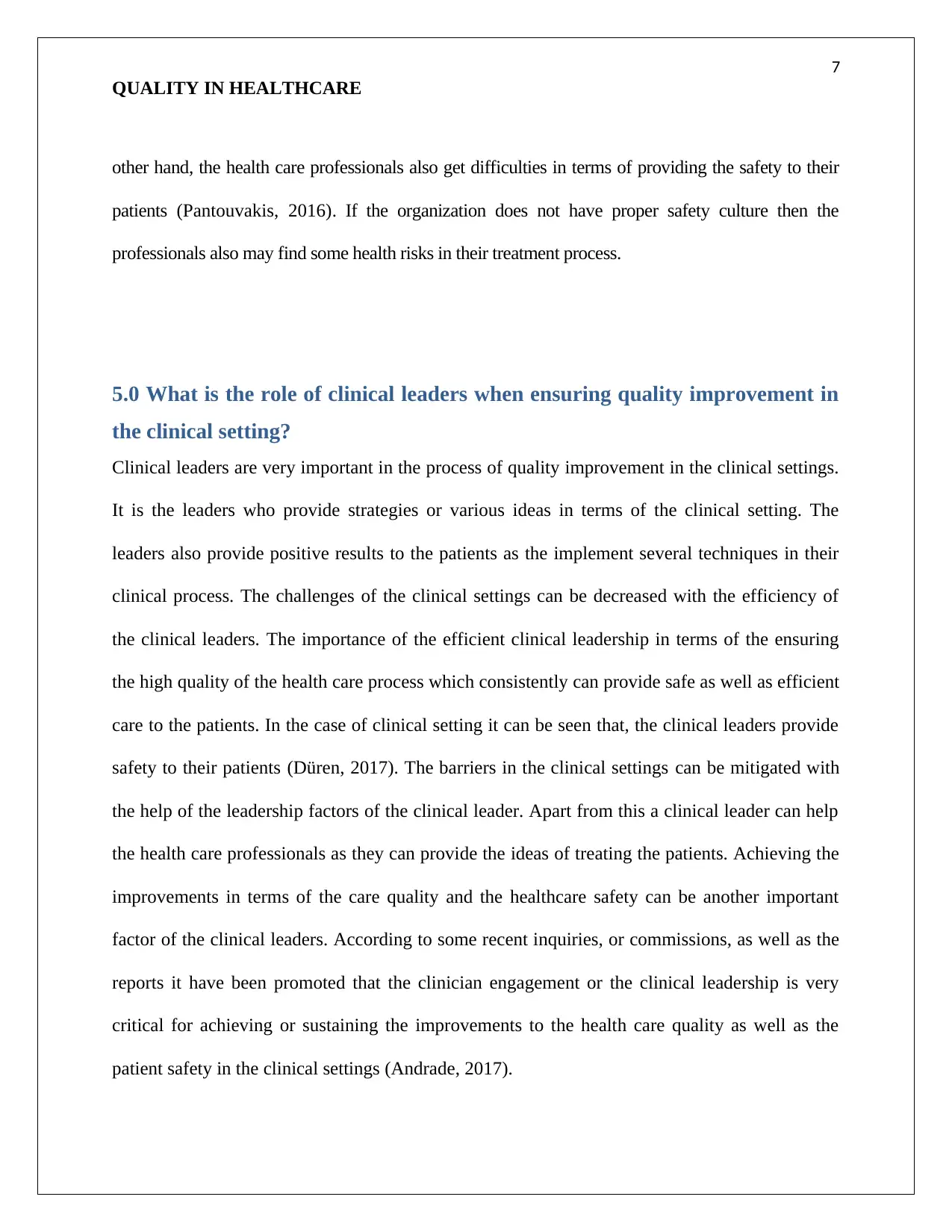
7
QUALITY IN HEALTHCARE
other hand, the health care professionals also get difficulties in terms of providing the safety to their
patients (Pantouvakis, 2016). If the organization does not have proper safety culture then the
professionals also may find some health risks in their treatment process.
5.0 What is the role of clinical leaders when ensuring quality improvement in
the clinical setting?
Clinical leaders are very important in the process of quality improvement in the clinical settings.
It is the leaders who provide strategies or various ideas in terms of the clinical setting. The
leaders also provide positive results to the patients as the implement several techniques in their
clinical process. The challenges of the clinical settings can be decreased with the efficiency of
the clinical leaders. The importance of the efficient clinical leadership in terms of the ensuring
the high quality of the health care process which consistently can provide safe as well as efficient
care to the patients. In the case of clinical setting it can be seen that, the clinical leaders provide
safety to their patients (Düren, 2017). The barriers in the clinical settings can be mitigated with
the help of the leadership factors of the clinical leader. Apart from this a clinical leader can help
the health care professionals as they can provide the ideas of treating the patients. Achieving the
improvements in terms of the care quality and the healthcare safety can be another important
factor of the clinical leaders. According to some recent inquiries, or commissions, as well as the
reports it have been promoted that the clinician engagement or the clinical leadership is very
critical for achieving or sustaining the improvements to the health care quality as well as the
patient safety in the clinical settings (Andrade, 2017).
QUALITY IN HEALTHCARE
other hand, the health care professionals also get difficulties in terms of providing the safety to their
patients (Pantouvakis, 2016). If the organization does not have proper safety culture then the
professionals also may find some health risks in their treatment process.
5.0 What is the role of clinical leaders when ensuring quality improvement in
the clinical setting?
Clinical leaders are very important in the process of quality improvement in the clinical settings.
It is the leaders who provide strategies or various ideas in terms of the clinical setting. The
leaders also provide positive results to the patients as the implement several techniques in their
clinical process. The challenges of the clinical settings can be decreased with the efficiency of
the clinical leaders. The importance of the efficient clinical leadership in terms of the ensuring
the high quality of the health care process which consistently can provide safe as well as efficient
care to the patients. In the case of clinical setting it can be seen that, the clinical leaders provide
safety to their patients (Düren, 2017). The barriers in the clinical settings can be mitigated with
the help of the leadership factors of the clinical leader. Apart from this a clinical leader can help
the health care professionals as they can provide the ideas of treating the patients. Achieving the
improvements in terms of the care quality and the healthcare safety can be another important
factor of the clinical leaders. According to some recent inquiries, or commissions, as well as the
reports it have been promoted that the clinician engagement or the clinical leadership is very
critical for achieving or sustaining the improvements to the health care quality as well as the
patient safety in the clinical settings (Andrade, 2017).
Paraphrase This Document
Need a fresh take? Get an instant paraphrase of this document with our AI Paraphraser
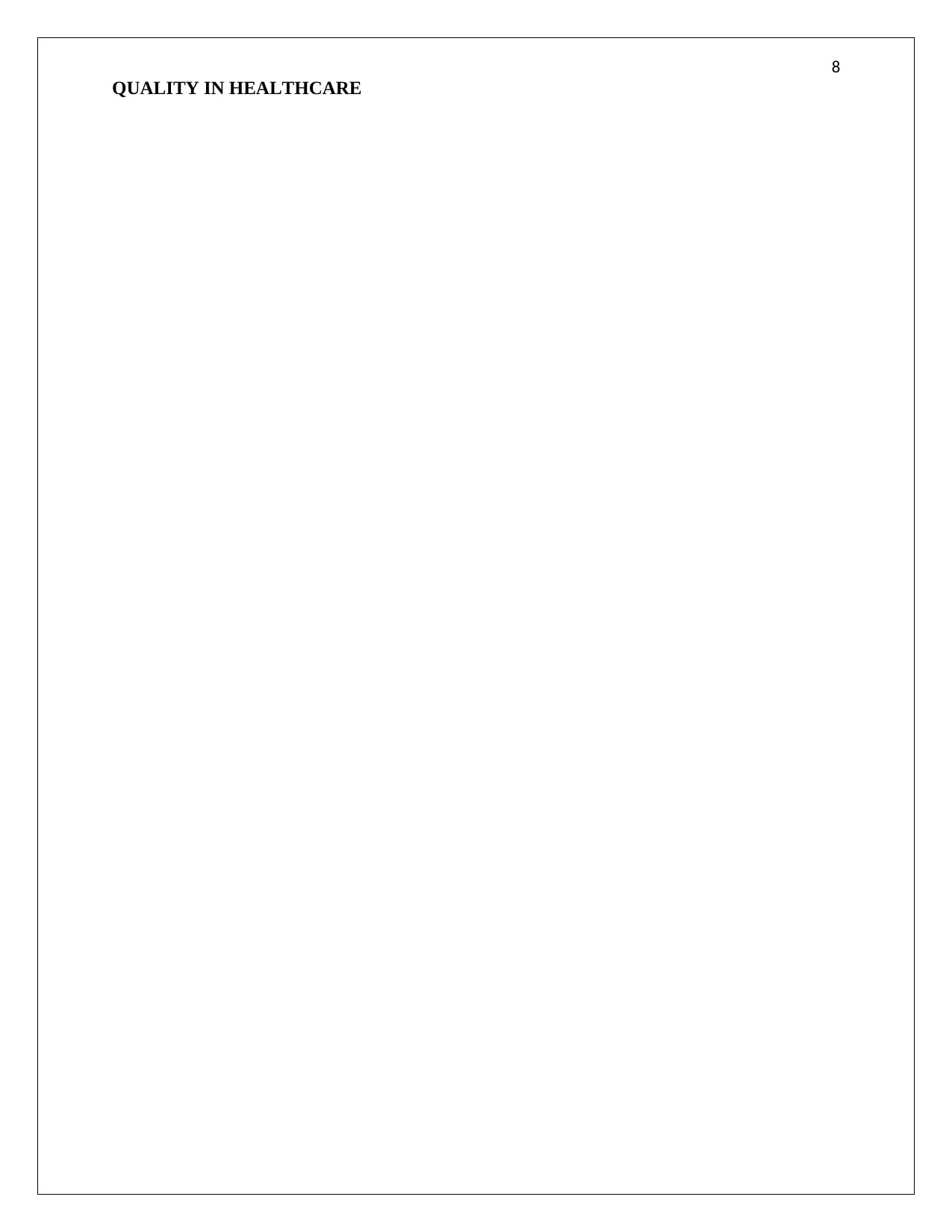
8
QUALITY IN HEALTHCARE
QUALITY IN HEALTHCARE
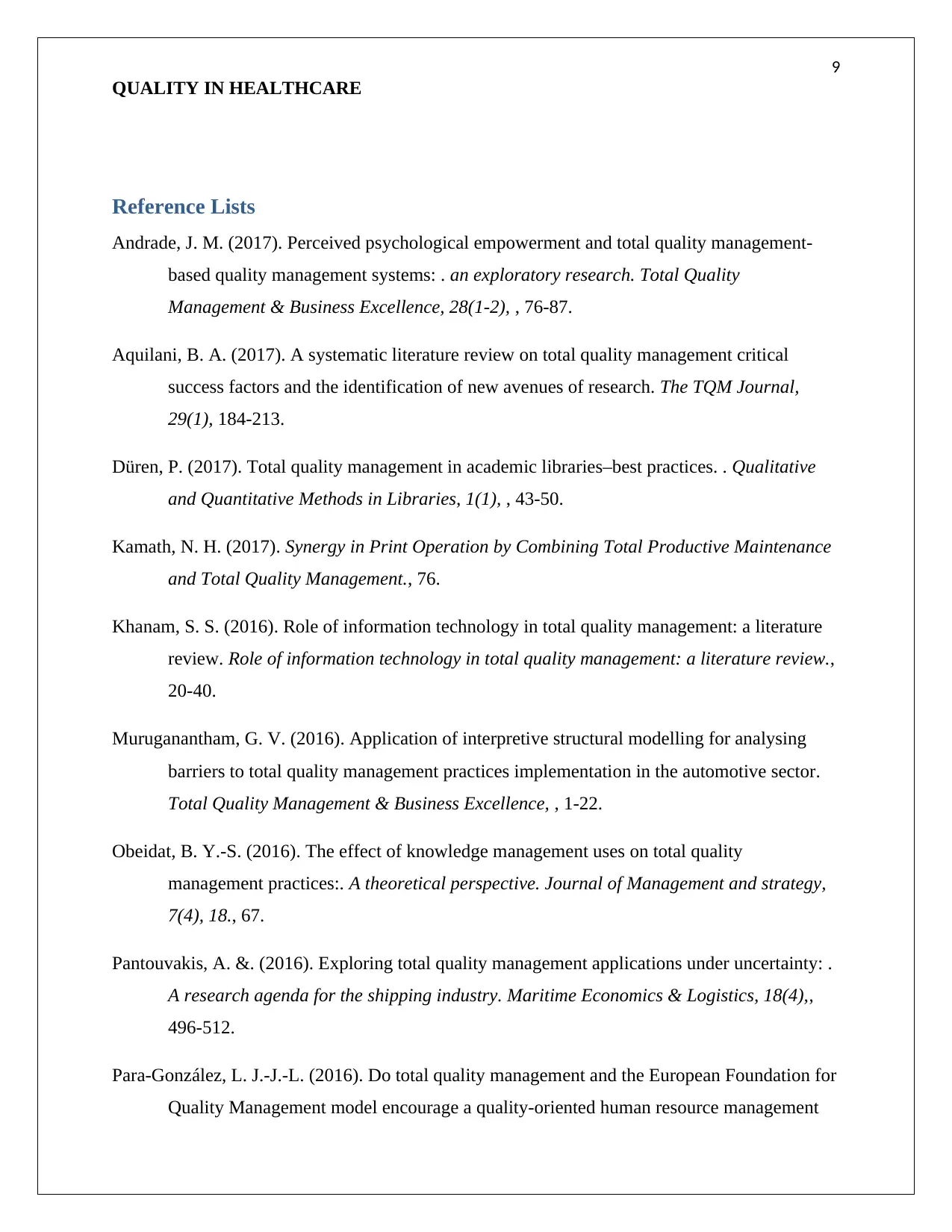
9
QUALITY IN HEALTHCARE
Reference Lists
Andrade, J. M. (2017). Perceived psychological empowerment and total quality management-
based quality management systems: . an exploratory research. Total Quality
Management & Business Excellence, 28(1-2), , 76-87.
Aquilani, B. A. (2017). A systematic literature review on total quality management critical
success factors and the identification of new avenues of research. The TQM Journal,
29(1), 184-213.
Düren, P. (2017). Total quality management in academic libraries–best practices. . Qualitative
and Quantitative Methods in Libraries, 1(1), , 43-50.
Kamath, N. H. (2017). Synergy in Print Operation by Combining Total Productive Maintenance
and Total Quality Management., 76.
Khanam, S. S. (2016). Role of information technology in total quality management: a literature
review. Role of information technology in total quality management: a literature review.,
20-40.
Muruganantham, G. V. (2016). Application of interpretive structural modelling for analysing
barriers to total quality management practices implementation in the automotive sector.
Total Quality Management & Business Excellence, , 1-22.
Obeidat, B. Y.-S. (2016). The effect of knowledge management uses on total quality
management practices:. A theoretical perspective. Journal of Management and strategy,
7(4), 18., 67.
Pantouvakis, A. &. (2016). Exploring total quality management applications under uncertainty: .
A research agenda for the shipping industry. Maritime Economics & Logistics, 18(4),,
496-512.
Para-González, L. J.-J.-L. (2016). Do total quality management and the European Foundation for
Quality Management model encourage a quality-oriented human resource management
QUALITY IN HEALTHCARE
Reference Lists
Andrade, J. M. (2017). Perceived psychological empowerment and total quality management-
based quality management systems: . an exploratory research. Total Quality
Management & Business Excellence, 28(1-2), , 76-87.
Aquilani, B. A. (2017). A systematic literature review on total quality management critical
success factors and the identification of new avenues of research. The TQM Journal,
29(1), 184-213.
Düren, P. (2017). Total quality management in academic libraries–best practices. . Qualitative
and Quantitative Methods in Libraries, 1(1), , 43-50.
Kamath, N. H. (2017). Synergy in Print Operation by Combining Total Productive Maintenance
and Total Quality Management., 76.
Khanam, S. S. (2016). Role of information technology in total quality management: a literature
review. Role of information technology in total quality management: a literature review.,
20-40.
Muruganantham, G. V. (2016). Application of interpretive structural modelling for analysing
barriers to total quality management practices implementation in the automotive sector.
Total Quality Management & Business Excellence, , 1-22.
Obeidat, B. Y.-S. (2016). The effect of knowledge management uses on total quality
management practices:. A theoretical perspective. Journal of Management and strategy,
7(4), 18., 67.
Pantouvakis, A. &. (2016). Exploring total quality management applications under uncertainty: .
A research agenda for the shipping industry. Maritime Economics & Logistics, 18(4),,
496-512.
Para-González, L. J.-J.-L. (2016). Do total quality management and the European Foundation for
Quality Management model encourage a quality-oriented human resource management
⊘ This is a preview!⊘
Do you want full access?
Subscribe today to unlock all pages.

Trusted by 1+ million students worldwide
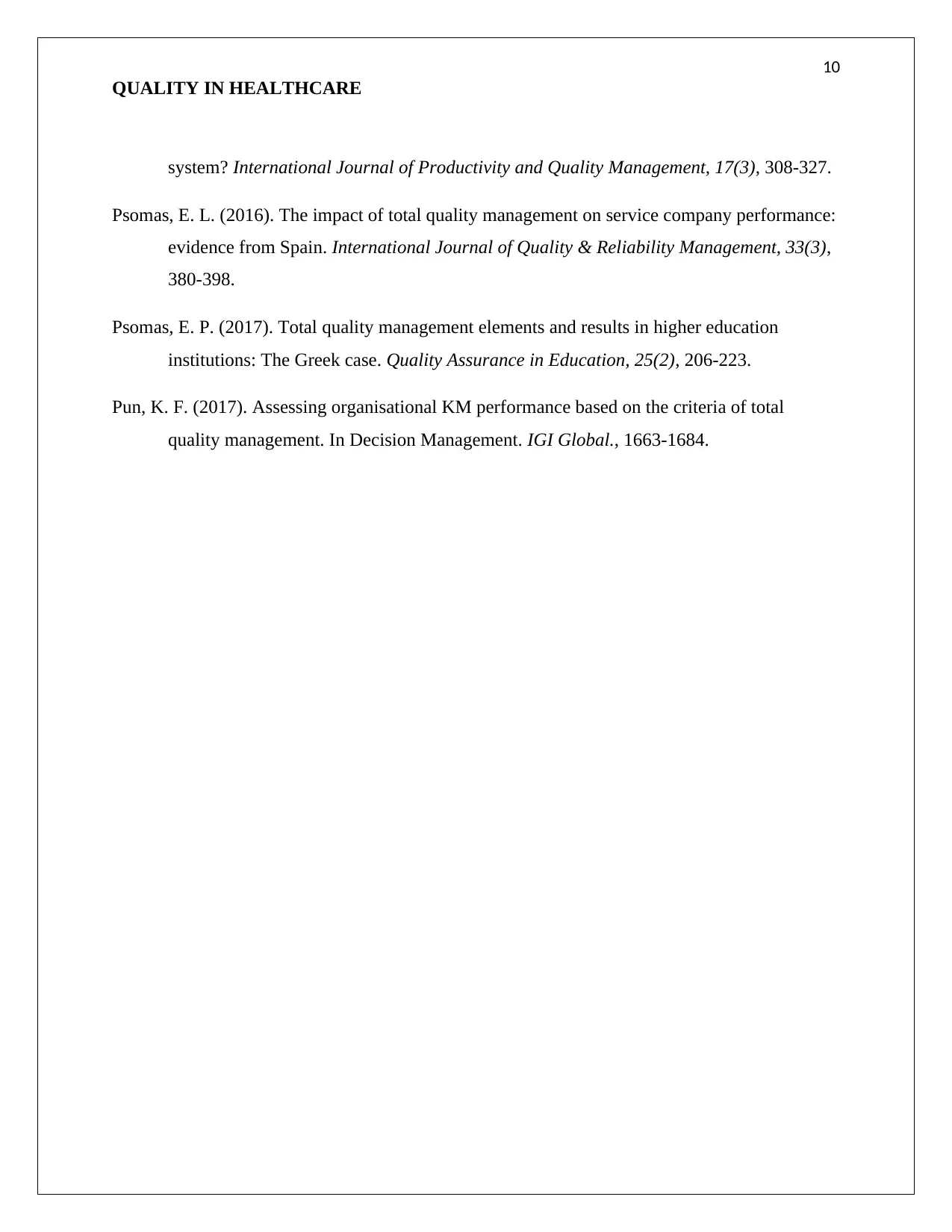
10
QUALITY IN HEALTHCARE
system? International Journal of Productivity and Quality Management, 17(3), 308-327.
Psomas, E. L. (2016). The impact of total quality management on service company performance:
evidence from Spain. International Journal of Quality & Reliability Management, 33(3),
380-398.
Psomas, E. P. (2017). Total quality management elements and results in higher education
institutions: The Greek case. Quality Assurance in Education, 25(2), 206-223.
Pun, K. F. (2017). Assessing organisational KM performance based on the criteria of total
quality management. In Decision Management. IGI Global., 1663-1684.
QUALITY IN HEALTHCARE
system? International Journal of Productivity and Quality Management, 17(3), 308-327.
Psomas, E. L. (2016). The impact of total quality management on service company performance:
evidence from Spain. International Journal of Quality & Reliability Management, 33(3),
380-398.
Psomas, E. P. (2017). Total quality management elements and results in higher education
institutions: The Greek case. Quality Assurance in Education, 25(2), 206-223.
Pun, K. F. (2017). Assessing organisational KM performance based on the criteria of total
quality management. In Decision Management. IGI Global., 1663-1684.
1 out of 10
Related Documents
Your All-in-One AI-Powered Toolkit for Academic Success.
+13062052269
info@desklib.com
Available 24*7 on WhatsApp / Email
![[object Object]](/_next/static/media/star-bottom.7253800d.svg)
Unlock your academic potential
Copyright © 2020–2025 A2Z Services. All Rights Reserved. Developed and managed by ZUCOL.





